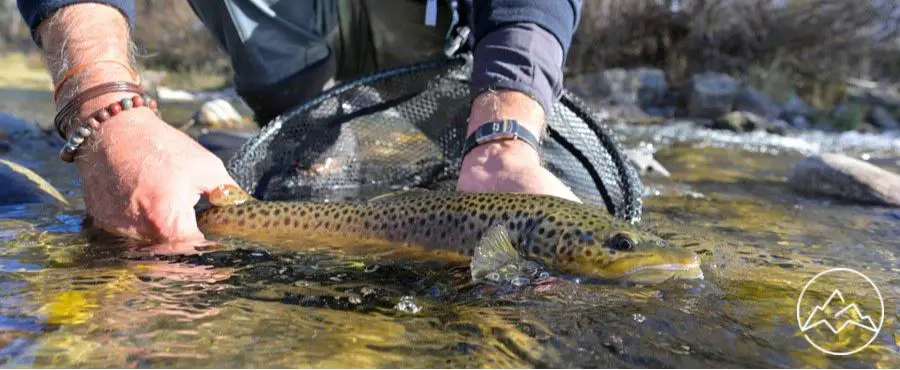Originally descended from European waters, over time, brown trout have been transferred to rivers and lakes around the world. In certain parts of South America like Argentina and Chile, these trout even reside in areas that run towards the ocean.
If you are new to brown trout fishing, it is key to employ the right techniques to make a catch, because this species of fish are not as abundant and is more challenging to catch than their close relatives, rainbow trout.
The good news is that many of the same tricks and techniques anglers use to catch rainbow trout are also effective for trout fishing. Brown trout are smaller than the rainbow variety, and a solid catch could be any fish exceeding 4 pounds. Some of the larger trout have been known to weigh more than 40 pounds (mostly in rare cases).
Today, we will walk you through exactly how to catch these types of trout, from setting your target to the best line and leader to tack options and more.
Where to fish for brown trout
As mentioned previously, most brown trout reside in freshwater areas like lakes, rivers, and even dams. In certain regions with estuaries and rivers, some live in the sea and migrate in from the ocean at particular periods of the year.
These trout are very difficult to catch and take on a more silver hue than the brown trout that reside in freshwater areas.
Setting your target
There are multiple approaches you can take for how to catch brown trout based on the region in which you live. Be sure to review the angling requirements and regulations in your area that will govern your endeavors, such as having a license to go brown trout fishing.
You can catch trout with bait, soft plastics, flies, or lures. You may go brown trout fishing from a stance on shore or in a boat with any of these types of bait as well. Fishing for trout is a sport in itself, as they fight hard and have even been known to jump or run after being hooked.
These trout possess very soft mouths, so you must take care not to set your drag too tight, or you risk losing a good catch. Slow and steady really does win the race when it comes to brown trout fishing, and a loose drag is critical to wear out the fish so you can reel them in swiftly.
Selecting your rod and reel
Anglers used to be limited to larger rods and reels in the earlier days of trout fishing, but now you have the option to use a 2 to 7-pound rod or more with a 1000 or 2500 reel as you prefer.
Your chosen rod length is purely a matter of personal preference, but fly fishing models ranging from six to seven feet in length are the recommended size. The best rods are designed from graphite, nano, or carbon fiber, making it easier to cast for hours because they are light on the arm.
Choosing your line and leader
When it comes to big brown trout fishing, there are a variety of line types you can pick from. With a braided line, you can pick one ranging from 4 to 12 pounds as you like. Line thickness doesn’t tend to vary too much, and it is a matter of your personal preference based on where you intend to fish and how sizable a trout you want to catch.
These factors will also affect the leader size you pick out as well. Any leader between 4 and 10 pounds will do the job. The best leaders are made with fluorocarbon or monofilament materials.
The best tackle
The following are your best tackle options to bag a successful catch:
- Hooks — If you’re fishing with bait, there is an array of hooks you can pick from based on your preference. Evaluate your bait choice and determine what hook is ideal for your bait according to its size. Between mud eyes, wattle grubs, worms, baitfish, and others, your hook choices are limitless.
- Sinkers — You want a tackle that is as lightweight as possible when trout fishing because the trout can sense if the weight is unnatural when it takes the bait. Ball sinkers and barrel sinkers are the best options.
- Jig heads — Select jig heads that are anywhere from 1/16th to 1/6th ounces based on the region and depth of the area in which you intend to fish. Consider the size of your hook when picking your jig head because you don’t want a tiny plastic with a huge hook or vice versa.
- Clips/snaps — If you opt for lures, you can use clips to secure them in order to enable you to switch lures quickly without needing to retie. The Size 00 clips are the best because they have a rating of about 18 pounds and are fairly small.
- Lures — The vast majority of lures are sold with integrated trebles, so you’ll want to try to pick the same hook size associated with the lure. Size 10 or 12 lures are usually your safest bet.
Lures and bait
There are hundreds of selections you could make when picking out your lure, streamer, Rapala, and spinner options. Remember, this kind of trout is a predatory creature, but you can use small lures with hard bodies all the way up to six-inch plastic lures as desired.
Be sure to match the bait to local water inhabitants. Wattle grubs, nightcrawlers, worms, and minnow imitations are fantastic bait options. Again, check your local regulations for bait requirements, because some areas forbid the use of worms as bait.
FAQs about Catching a Brown Trout Fish
What is the best time of year to catch a brown trout?
What baits are most effective for catching brown trout?
What types of lures and flies should be used when targeting brown trout?
What water temperature is ideal for catching brown trout?
How deep do brown trout typically swim in lakes and streams?
Final brown trout fishing tips
Understand that trout can be finicky and could follow lures without even taking them. If this happens, you might need to change up the color or retrieve the lure to instigate their interest.
These types of trout love to spend time in areas that give them a place to hide, so fishing around trees, logs, rocks, or similar almost guarantees you’ll find them. The trout enjoy running water so you will typically locate them hiding out in areas with high flow rates.
If you use lures, fish with large rips and jerking strokes to imitate the baitfish and make for an optimal retrieve. Finally, you may also consider using a landing net, as this will make it easier to catch the trout rather than just picking it up or attempting to beach it.




Small amount of air in half a crawler with a slip sinker…. adjust sinker to suit current,depth and bottom structure.